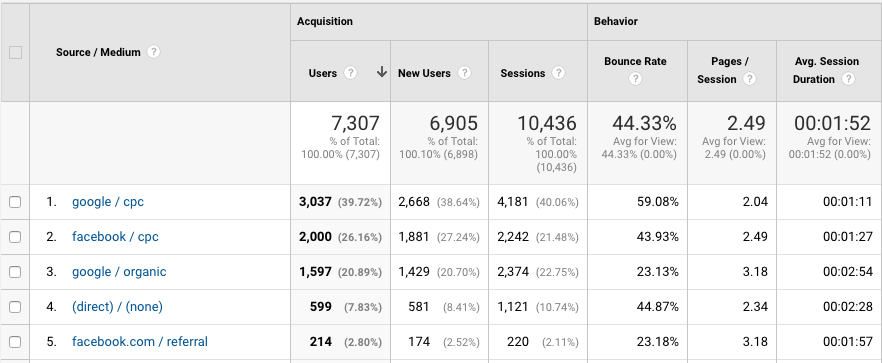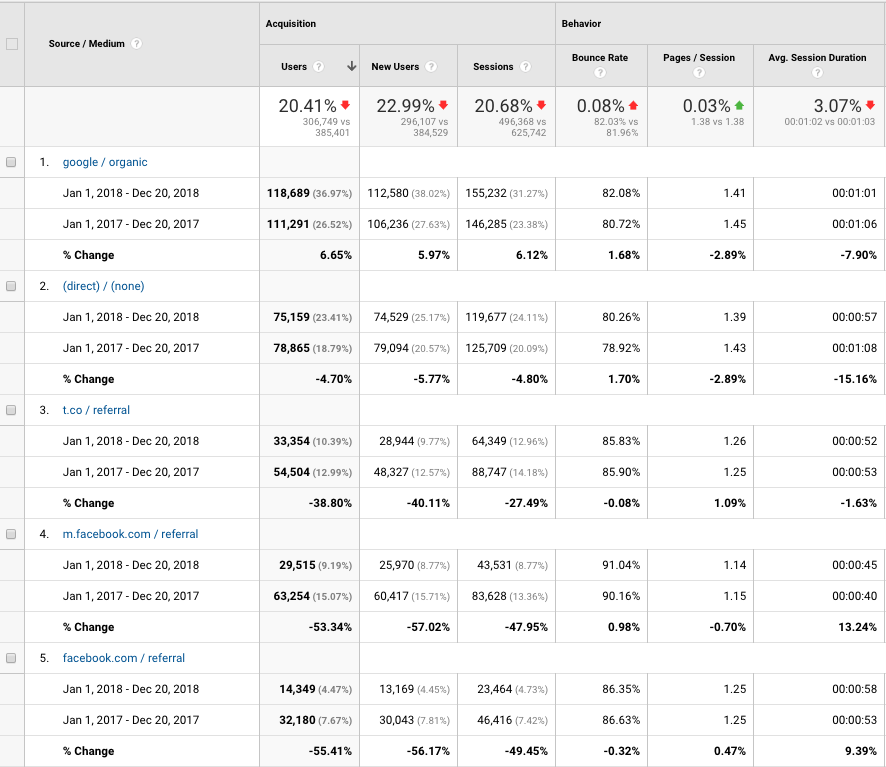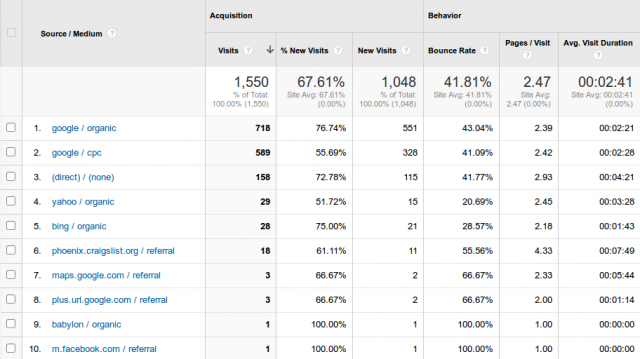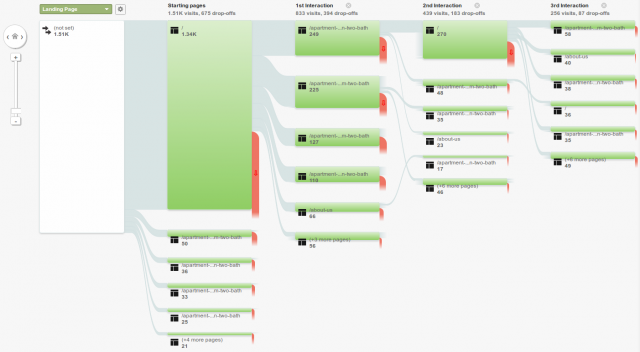John Wanamaker, the father of modern advertising, captured this frustration perfectly with his classic quotation:
Half the money I spend on advertising is wasted; the trouble is I don't know which half.
One of the most powerful opportunities we have in the digital era as marketers is the ability to see exact metrics and measurements to quantify the exact value of each marketing source.
Suddenly, we can see precisely which sources are carrying their weight, and which expensive advertising sources we can cut without problems.
In the past, this kind of marketing, which a friend of ours called "accountable marketing" when we shared the ideas with him, was a contradiction in terms. How can something be accountable if you don't have data to measure it? But in the age of tracking numbers and analytics software, that's no longer true. Thanks to these technologies, we can know a great deal about how our marketing channels are performing.
Of course, even today too many people in our industry think that marketing exists in a dataless void staffed by creative people who come up with funny ideas that entice consumers to act. It's all magic and art and originality and... well, you just hope it works. But if it doesn't.... well, who do you blame? What do you change? Far too often the answer to these questions is a tired shrug or an unhappy "I don't know."
The uncertainty is the real problem. When you don't know what works and what doesn't, you can't decide where to invest your marketing dollars. The total mystery behind the true value of your various marketing sources was a terrifying game of Jenga—pull out the wrong source, and your whole business might fall to pieces.
Step One: Measure the Data
Before we can know anything about the true performance of our marketing sources, we obviously need to start collecting data somehow. Specifically, this means that we need to collect data (at the very least) from two major sources:
- We need data from our website, which is the hub of our marketing platform.
- We need data from actual leads (i.e., phone calls).
Install Google Analytics.
For collecting performance data from our website, Google Analytics is the industry-standard software, and the normal version is free. Google Analytics is incredibly powerful software that can take the span of an entire career to master, but don't procrastinate getting it installed on your website.
Google Analytics is only helpful once you have collected some data to segment, query, and measure. If you install Analytics today, you can begin collecting data, even if you don't have a clue what to do with it. So, go, right now. Install Analytics before you read any further. Seriously. We mean it.
Set up call tracking.
Secondly, you need to set up some kind of call tracking software to measure which leads are coming in from which sources.
Unless you can differentiate which sources are actually generating your leads, all the other data in the world makes absolutely no difference whatsoever.
Call tracking, though, is a pretty straightforward science. Once you have a tool that will count the number of phone calls by source (consolidating duplicate callers, of course) and give you average call duration data (broadly speaking, call length is often an indicator of call quality), there isn't too much room to dive deeper into your call data. From those reports, you should have a pretty accurate picture of your ad sources' call volumes.
Step 1.5: The RentVision Platform
We'll continue on with the rest of the post in a moment, but we did want to take a moment to note that if you work with us as a marketing partner, you have access to our apartment marketing software which pulls your website data and call tracking data into a single dashboard for you to view.
In other words, if you work with us, then all the data tracking is already happening and you can see the results anytime you want.
Step 2: Analyze the Data
Though it is more complicated than phone data, website analytics data is a treasure trove of insight into your marketing situation. If you know how to listen to your website data, you can figure out how to make lots of small, incremental changes to your website's performance that add up to big, lead-generation differences.
Call tracking, you see, only allows reactive decisions. If you see a source underperforming, you can cut it from your budget. That data, however, doesn't tell you anything about why the source might be underperforming, or what you need to do to make the source work more effectively for you.
But with Google Analytics, you can figure out precisely where the breakdown is in your process in order to make proactive changes.
Adjusting Low-Performing Traffic Sources
Let's begin by adjusting the traffic sources that might not be performing well for us. Take the Google Analytics "Channels" report, which you will find under "Acquisition" and then the "All Traffic" drop down on the left-hand sidebar. With this shot, you should see a page that looks like this:
From this screen, you can start to evaluate factors such as visit numbers, bounce rates, and average visit duration by source. So, if we were looking at this and saw high bounce rates or low visit durations for "google / cpc" (that is, Google Ads "cost-per-click") traffic, we would probably want to re-evaluate our ad spend here. (At this community, however, Ads accounts for roughly 40% of the leads they receive through their website.)
Note that you can also see average pages viewed per visit and average time on the site, both sorted by marketing channel.
What this allows you to do is to begin to tell a story about how your marketing is performing. One of the challenges with analyzing data is that none of this marketing data is self-interpreting. It doesn't tell you what it means. You need to view it and interpret it to the best of your ability.
To understand how this works, let's take two examples. First, here is a screen cap showing the top five traffic sources over a given time-span for one Class A community we work with:

If you look at this data, you'll see that we have been able to send them a considerable amount of traffic via Google and Facebook ads. (Facebook ads continue to be a very touchy and unreliable platform and so far much of our success is with Class A properties, but, as you can see, there are places where it seems to be doing quite well.)
That being said, don't focus exclusively on the "users" and "sessions" data. That can mislead you. Yes, these advertisements are generating a lot of traffic for us. But look at the bounce rate, pages per visit, and visit duration. The numbers on the ads in the top two spots are not bad by any stretch, but check out the results with organic search. The bounce rate is between 1/2 and 1/3 what it is with the advertising traffic. Organic visits look at one more page per visit on average and they spend double or nearly three times as long on the site as traffic coming from the CPC channels.
How do you interpret this data? Well, you can come to these kind of conclusions:
- Both Google and Facebook ads are reliable traffic generators that get visitors onto the site.
- Visitors from these ads are not unengaged and some probably convert to leases. (You'd need lease-tracking data to say for sure, which is another topic for another day.)
- Organic search traffic from Google is by far the most engaged traffic they can generate.
So what kind of work would you do based on this data?
- You'd continue to invest in ads as needed based on your community's vacancy numbers and related traffic and lead gen needs.
- You'd look for ways to increase organic search traffic to your website as that traffic tends to be more engaged.
Let's take one more example. This is not an apartment website. It is the website of a side project that one of our employees maintains. In this case, we're going to display year-over-year traffic sorted by channel.

The big thing to note here is that if you look at the top, the initial number looks really bad: users down 20% year-over-year. Yikes!
But then look closer: Organic search is up slightly. Direct is more or less holding steady. It's on social media and especially Facebook where we are seeing the biggest drop. And if you follow the news, you know that in January of 2018 Facebook made major changes to their algorithm to determine what shows up in News Feed, with the effect being that referral traffic to outside websites from Facebook dropped dramatically.
What does this example show us, then? It shows us the importance of interpreting data. At first glance, you might think something really bad has happened and the magazine needs to make major changes to how they publish to recover lost traffic from the past year. But when you dig a bit more, you see that the drop is almost entirely explainable by the changes Facebook has made to their algorithm.
So the lesson for the magazine, if anything, is not to panic and make tons of changes, but to recognize the dangers of relying on Facebook for traffic and to work toward a traffic source we can actually maintain.
Being able to interpret data in this way is vital because if you have data but don't know how to interpret it you can make serious mistakes.
Adjusting Low-Performing Websites
But let's say that your lead sources seem to be performing pretty well. Once they arrive at your site, how well are they moving through the site, and how often do they end up converting?
This is where the Google Analytics Behavior Flow tool (under "Behavior") comes in really handy, because it gives a visual representation of how many people are flowing through the various pages on your website, and how many are dropping off by leaving your website.
From here, you can get a 50,000-foot view of how your website is performing. If you see a sizable dropoff of people at any single point on the website, that spot may be a bottle-neck that you will want to address with better content, better organization, or better calls to action.
Adjusting Low-Performing Pages
Finally, one of the most precise tools in Google Analytics is found by looking at the Behavior --> Site Content --> All Pages page.
Here, you get a breakdown of behavior on each of the pages (and especially, of the individual floorplan landing pages) on your website. For educational purposes, here's a sample breakdown of individual pages:
In this example, you will note that apartment-5 has a significantly lower average time on page and a significantly higher bounce rate than the other floorplans. When we start to see significant statistical differences like this, we can start asking ourselves what might cause the changes. (In this case, the difference was from a floorplan that didn't have photos or walkthrough video tours to engage visitors to the site.)
Step 3: Make smart adjustments.
Once you have started gathering marketing data and have analyzed it, you need to make decisions about what to do based on what you've learned. We've hinted at what some of that might look like above.
Maybe you're seeing a floorplan page that is under-performing. Are the photos on that page bad? Or perhaps the page is just not attracting the same amount of traffic and you can't really evaluate the quality because there is so little traffic moving to it? There are lots of possibilities.
Here are three principles to keep in mind when making adjustments.
State the problem objectively and define concrete goals.
Before doing anything, make sure you can define what you think the problem is, what you plan to do to resolve the problem, and what your standard of success will be when deciding if you have solved the problem. Use this sentence as a template: "We believe that our current marketing problem is (blank). We believe this because of (blank). We plan to fix this problem by doing (blank). Our goal will be (blank)."
For example, you might say, "We believe that our current marketing problem is insufficient leads. We believe this because we only received 25 calls in the past month. We plan to fix this problem by increasing our ad spend on Google Ads to $750/month. Our goal is to generate 40 phone calls in the next 30 days."
By structuring your work in this way, you are stating the problem clearly and defining both what you are going to do (action) and what you hope to accomplish (goal). The goal here is to pull in as much objective data as you can because objective data creates consensus within your team.
Your team might have arguments about what "improve marketing" means. But if the stated goal is to generate 40 leads in the next 30 days and you plan to do this by increasing your ad spend to $750/month, you remove some of the personal components to this and focus the discussion around the data.
Objective data should also help with buy-in from the higher-ups in your company because they can see exactly what you are trying to accomplish and know what the measure of success will be.
Think realistically about goals and objectives.
One of the challenges that can happen with apartment communities, especially communities struggling with vacancy problems, is that the urgency of the situation can cause people to act impulsively. If your community is at 77% occupancy, that's obviously a major problem. But it's not a problem you can simply solve overnight. You need to go to the data and break things down into more approachable segments.
To keep things simple, let's say this community has 100 units and is at 77% occupancy. We'll also say that they don't have any notices for the next 60 days, so they know they don't have to fill any additional units during that time. So what should they be doing?
Well, they have 23 units to fill. So they can start by asking these kind of questions?
- Are we generating enough leads on a month-to-month basis?
- How does our leasing team do with turning leads into leases?
- What is the comparison between the cost of some fairly significant rent cuts on a select number of units in order to rent them faster and the cost of ongoing vacancy?
All of these are questions you can answer objectively. How many apartments do you need to lease in a typical month? What percentage of leads convert to leases? If you can answer those two questions you know how many leads you should generate normally. You also have a ballpark idea of how many leads you might need to generate to deal with a vacancy crisis. If you typically need 10 leads to get two leases and right now you need six leases, then you probably need to generate thirty leads—or you need to convert your leads at a higher rate.
The trick is to teach yourself and your team to stop thinking in terms of "we have a vacancy crisis" and to think instead in terms of "we need to generate x number of leads or y number of leases." By defining the problem concretely and then breaking it down into manageable parts, you can fight the tendency many communities have to panic when dealing with a vacancy problem.
Use marketing data to make revenue decisions.
Rent rates are a function of simple economics: You charge what you can based on the supply of available units and the demand for those units.
The trouble, of course, is that communities often don't have a clear sense of what the demand is and are in reaction mode when it comes to knowing their supply. In other words, they don't know their supply until it's too late to plan and then they have to panic if the news is bad.
This is all kind of silly and unnecessary. You can know what the demand for your units is. It's all right there in your Google Analytics data. If you know that you have more supply coming available, you can manufacture demand by increasing your ad spend.
The key is to make sure that your decisions about rent rates and managing community revenue are being influenced by the marketing data you have in Google Analytics.
Conclusion
Accountable marketing isn't a myth. It's a reality. Set up Google Analytics. Set up call tracking. Monitor the data, analyze it, make informed decisions. There's a better way to market apartments because there is a better way to manage your community. Take advantage of the data that is available to you and reap the benefits.




